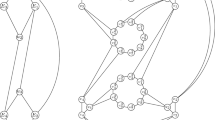Abstract
We propose new practical algorithms to find degree-relaxed variants of cliques called s-plexes. An s-plex denotes a vertex subset in a graph inducing a subgraph where every vertex has edges to all but at most s vertices in the s-plex. Cliques are 1-plexes. In analogy to the special case of finding maximum-cardinality cliques, finding maximum-cardinality s-plexes is NP-hard. Complementing previous work, we develop combinatorial, exact algorithms, which are strongly based on methods from parameterized algorithmics. The experiments with our freely available implementation indicate the competitiveness of our approach, for many real-world graphs outperforming the previously used methods.
Preview
Unable to display preview. Download preview PDF.
Similar content being viewed by others
References
Abu-Khzam, F.N., Fellows, M.R., Langston, M.A., Suters, W.H.: Crown structures for vertex cover kernelization. Theory Comput. Syst. 41(3), 411–430 (2007)
Balasundaram, B., Butenko, S., Hicks, I.V., Sachdeva, S.: Clique relaxations in social network analysis: The maximum k-plex problem (February 2008) (manuscript), http://iem.okstate.edu/baski/files/kplex4web.pdf
Batagelj, V., Mrvar, A.: Pajek datasets (2006), http://vlado.fmf.uni-lj.si/pub/networks/data/ (accessed, January 2009)
Chesler, E.J., et al.: Complex trait analysis of gene expression uncovers polygenic and pleiotropic networks that modulate nervous system function. Nat. Genet. 37(3), 233–242 (2005)
DIMACS. Maximum clique, graph coloring, and satisfiability. Second DIMACS implementation challenge (1995), http://dimacs.rutgers.edu/Challenges/ (accessed, November 2008)
Fellows, M.R., Guo, J., Moser, H., Niedermeier, R.: A generalization of Nemhauser and Trotter’s local optimization theorem. In: Proc. 26th STACS, Germany, pp. 409–420. IBFI Dagstuhl, Germany (2009)
Grossman, J., Ion, P., Castro, R.D.: The Erdős number project (2007), http://www.oakland.edu/enp/ (accessed, January 2009)
Komusiewicz, C., Hüffner, F., Moser, H., Niedermeier, R.: Isolation concepts for enumerating dense subgraphs. In: Lin, G. (ed.) COCOON 2007. LNCS, vol. 4598, pp. 140–150. Springer, Heidelberg (2007)
McClosky, B., Hicks, I.V.: Combinatorial algorithms for the maximum k-plex problem (January 2009) (manuscript), http://www.caam.rice.edu/~bjm4/CombiOptPaper.pdf
Niedermeier, R.: Invitation to Fixed-Parameter Algorithms. Oxford University Press, Oxford (2006)
Nishimura, N., Ragde, P., Thilikos, D.M.: Fast fixed-parameter tractable algorithms for nontrivial generalizations of Vertex Cover. Discrete Appl. Math. 152(1-3), 229–245 (2005)
Östergård, P.R.J.: A fast algorithm for the maximum clique problem. Discrete Appl. Math. 120(1-3), 197–207 (2002)
Sanchis, L.A., Jagota, A.: Some experimental and theoretical results on test case generators for the maximum clique problem. INFORMS J. Comput. 8(2), 103–117 (1996)
Seidman, S.B., Foster, B.L.: A graph-theoretic generalization of the clique concept. Journal of Mathematical Sociology 6, 139–154 (1978)
Wu, B., Pei, X.: A parallel algorithm for enumerating all the maximal k-plexes. In: Washio, T., Zhou, Z.-H., Huang, J.Z., Hu, X., Li, J., Xie, C., He, J., Zou, D., Li, K.-C., Freire, M.M. (eds.) PAKDD 2007. LNCS (LNAI), vol. 4819, pp. 476–483. Springer, Heidelberg (2007)
Author information
Authors and Affiliations
Editor information
Editors and Affiliations
Rights and permissions
Copyright information
© 2009 Springer-Verlag Berlin Heidelberg
About this paper
Cite this paper
Moser, H., Niedermeier, R., Sorge, M. (2009). Algorithms and Experiments for Clique Relaxations—Finding Maximum s-Plexes. In: Vahrenhold, J. (eds) Experimental Algorithms. SEA 2009. Lecture Notes in Computer Science, vol 5526. Springer, Berlin, Heidelberg. https://doi.org/10.1007/978-3-642-02011-7_22
Download citation
DOI: https://doi.org/10.1007/978-3-642-02011-7_22
Publisher Name: Springer, Berlin, Heidelberg
Print ISBN: 978-3-642-02010-0
Online ISBN: 978-3-642-02011-7
eBook Packages: Computer ScienceComputer Science (R0)




